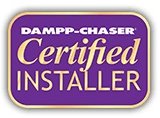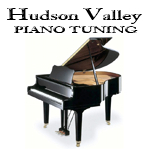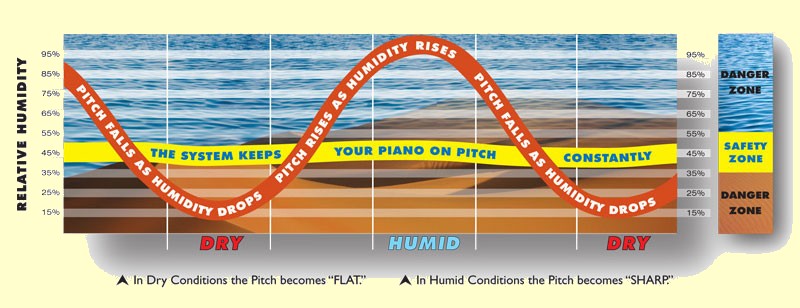Dampp-Chaser System Benefits
Effects of Low Humidity
Over time, constant changes in humidity levels, with the corresponding shrinking and swelling of the soundboard, will damage the integrity of the soundboard. You will see this damage in the form of a crack in the soundboard.
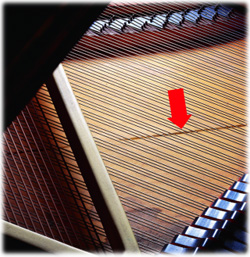
Effects of High Humidity
Apart from the strings, your piano is almost entirely made of wood. Like the living trees that were the source of your piano, wood responds to climate and environment - it breathes, stretches and flexes. All wood instrument musicians are familiar with the effects of humidity levels. Guitar players must frequently adjust their bridge heights and fingerboard action. Violinists must pay close attention to maintaining constant, ideal humidity levels - or else they may find their violin rather dramatically springing apart during a performance!
Just as with other wood-based instruments, your piano needs a constant level of ideal humidity - between 40% - 50% - to maintain its pitch and tone, quality of action, and to prevent permanent damage.
Prevent Sticking Keys
Just as doors and drawers become tight and difficult to move, the keys of your piano may stick down when struck in times of high humidity.
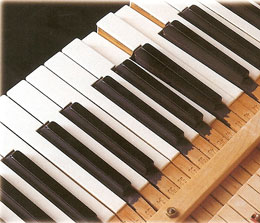
Prevent Sluggish, Unresponsive Keyboard Action
As you play your piano, you will notice how responsive the keys are to your touch. The way the keys cause the hammers to strike the piano strings is part of thousands of interconnected wooden parts called the piano action. With high moisture levels in the piano action, the action is sluggish, and the keys seem non-responsive to your touch.
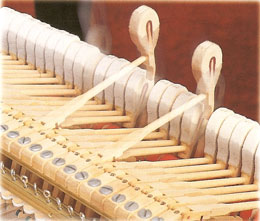
Prevent Serious Rust Damage to Strings and Pins
The strings of your piano are responsible for producing the musical sounds. With exposure to high humidity levels over long periods, strings become rusted and corroded.
At the junction where rusted strings wrap around rusted pins, rust corrosion forms a hardened bond between the two. Then, during a tuning, when your piano technician turns the pins to stretch the strings, the inflexible, rusted string snaps at this joint.
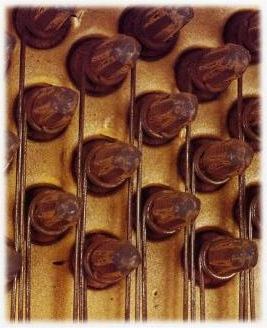
Rusty tuning pins and strings
Effects from Humidity Fluxuations
Prevent Costly Bridge Damage
The soundboard is the single largest piece of wood in your piano. It actually vibrates to amplify the sound produced by the strings. The bridges of your piano are joined to the soundboard and support the strings.
When the soundboard shrinks and flattens, the tension of strings over the bridge becomes inadequate. The pitch of the mid-range and treble section is now flat.

Dry soundboard
The opposite happens when the absorbs water. As it sells, the bridge is pushed up which makes the pitch of the mid-range and treble section is go sharp. I have seen this cycling action as I tune pianos in the dry fall months, and again in the humid summer months of the Tri-State area.

Soundboard with a high moisture content
Prevent Pinblock Damage
In dry periods, the wood shrinks away from the pin, loosening it and causing the string to sag. When this cycle is repeated time after time, the wood fibers surrounding the pin are destroyed and lose their resilience.
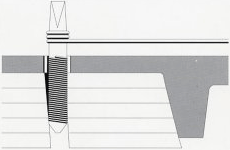 Dry Pin Block
Dry Pin Block
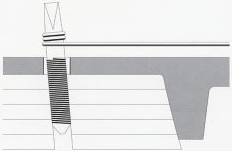 Moist Pin Block
Moist Pin Block
In this picture, the pinblock (without pins) was removed from a piano during restoration. With continuous swelling and shrinking, the wood could no longer provide the snug fit required to hold pins in place.
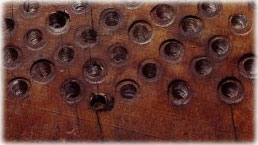
This chart demonstrates how drastically pitch can change when your piano is exposed to fluctuations in the humidity during seasonal weather changes.

